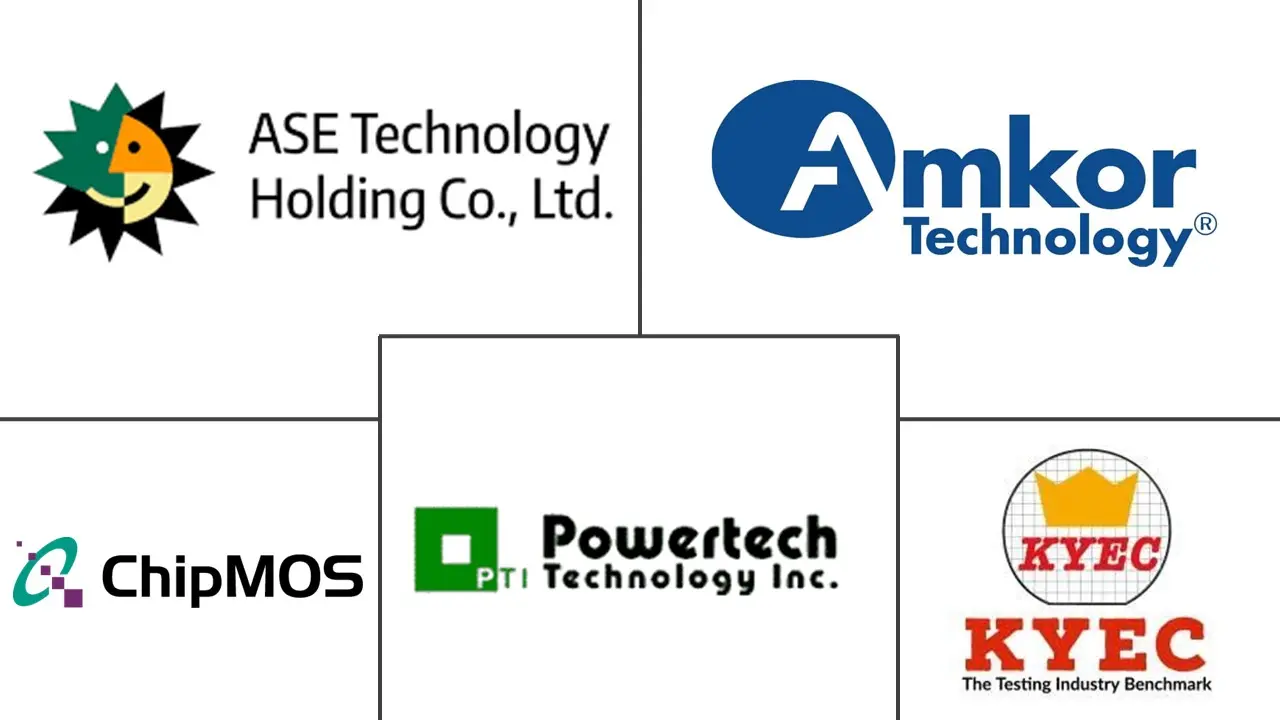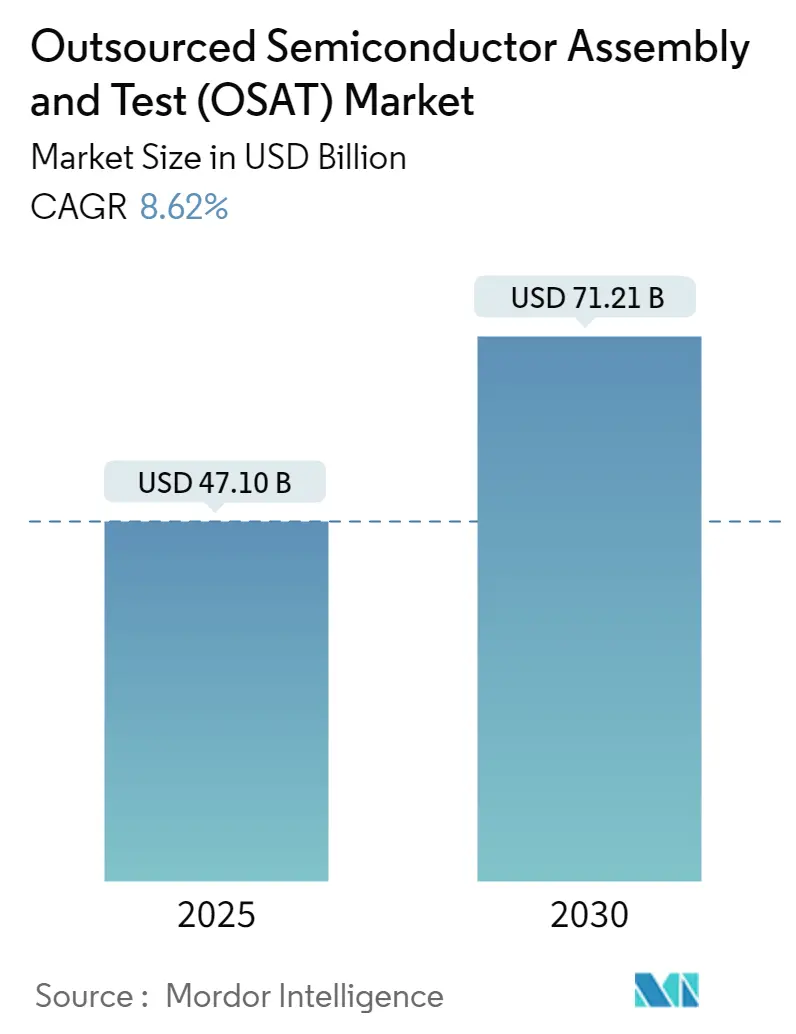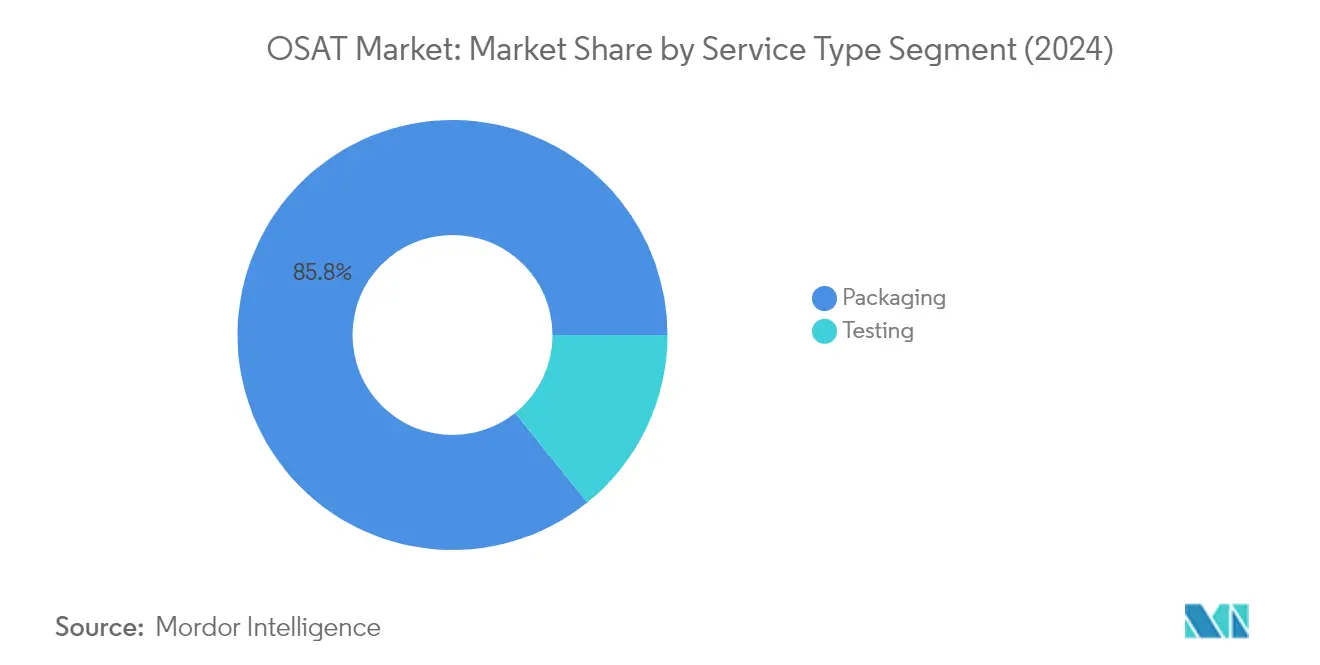Outsourced Semiconductor Assembly and Test (OSAT) Market Size
Outsourced Semiconductor Assembly and Test (OSAT) Market Analysis
The Outsourced Semiconductor Assembly and Test Market size is estimated at USD 47.10 billion in 2025, and is expected to reach USD 71.21 billion by 2030, at a CAGR of 8.62% during the forecast period (2025-2030).
The semiconductor industry is experiencing a transformative phase with an increasing focus on advanced packaging market technologies as traditional scaling approaches reach their physical and economic limits. According to the Semiconductor Industry Association, approximately 31% of all semiconductors manufactured are utilized for communications applications, including networking equipment and smartphone radios, highlighting the critical role of OSAT market services. The industry has witnessed significant investments in 2023, with TSMC announcing a USD 2.85 billion investment in July to establish an advanced chip packaging plant in Miaoli, northern Taiwan, scheduled to begin volume production around mid-2027. This trend of major investments reflects the industry's shift towards more sophisticated packaging solutions to meet evolving technological demands.
The integration of artificial intelligence and high-performance computing applications has created unprecedented demands for advanced packaging solutions. In July 2023, Silicon Box launched a USD 2 billion advanced semiconductor packaging facility in Singapore, aimed at revolutionizing chip manufacturing and enhancing local capabilities. The GSMA projects that 5G adoption will reach 54% globally by 2030, equivalent to 5.3 billion connections, driving demand for sophisticated packaging solutions. This technological advancement is expected to contribute nearly USD 1 trillion to the global economy, creating substantial opportunities for OSAT market growth providers.
The industry is witnessing a significant geographical shift in manufacturing capabilities, with more than 90% of the assembly and testing base currently concentrated in Asia. Major industry players are expanding their capabilities through strategic investments and technological innovations. In March 2023, Samsung announced plans to invest USD 230.8 billion over 20 years in South Korea's push to build a mega semiconductor hub, demonstrating the scale of investment being directed towards advancing packaging capabilities. These developments are reshaping the competitive landscape and driving innovation in packaging technologies.
The emergence of heterogeneous integration and advanced packaging solutions is revolutionizing the semiconductor industry. Intel demonstrated this trend by delivering its first multi-chip package prototypes in April 2023 under the Heterogeneous Integrated Packaging (SHIP) program for the U.S. Department of Defense. The company claims its multi-chip packaging capabilities deliver up to 10 times any other product's weight, power, and size advantage. This advancement in semiconductor packaging technology is enabling new possibilities in chip design and performance, particularly for applications requiring high computational power and energy efficiency.
Outsourced Semiconductor Assembly and Test (OSAT) Market Trends
Increased Applications of Semiconductors in Automotive
The automotive industry has emerged as a primary driver for OSAT market growth, with increasing semiconductor content per vehicle driven by the rapid adoption of electric vehicles and advanced driver assistance systems (ADAS). According to the China Passenger Car Association, the country sold 5.67 million EVs and plug-ins in 2022 as consumers shifted from traditional vehicles due to government subsidies and rising oil costs. This surge in EV adoption has created substantial opportunities for OSAT vendors, as electric vehicles require significantly more semiconductor content than traditional vehicles.
The advancement of ADAS technology has further accelerated the demand for sophisticated packaging solutions. In August 2022, the UK government unveiled plans to invest EUR 100 million towards introducing self-driving vehicles by 2025. Major semiconductor manufacturers are responding to this demand through strategic partnerships and investments. For instance, in February 2023, GM signed a long-term agreement with GlobalFoundries to establish exclusive production capacity of U.S.-produced semiconductor chips. Additionally, in May 2023, Denso Corporation announced a collaboration to produce insulated gate bipolar transistors (IGBT), which have entered mass production at USJC's 300mm fab, with production expected to reach 10,000 monthly wafers by 2025.
Advancement in Semiconductor Packaging Owing to Trends Like 5G
The evolution of 5G technology has become a significant catalyst for innovations in semiconductor packaging, driving the development of advanced packaging solutions to meet the demanding requirements of 5G applications. Advanced packaging, which was introduced around 2000, is now gaining high momentum as the next breakthrough in semiconductor technology. End-user trends such as 5G, AI, high-performance computing (HPC), IoT, machine-to-machine (M2M), cloud and data center, GPU, AR/VR, and deep and machine learning are further driving packaging innovation. These applications need high-performance, low-power chips that can rapidly process massive quantities of data.
The rising commercialization of applications in packaging platforms, such as Fan-Out Packaging and the 3D Flip Chip technology, is addressing the high-power consumption needs while providing advantages such as greater chip connectivity. Since the mid-2010s, fan-out wafer-level packaging has dominated with about 65% market share, as it is more cost-effective compared to stacking and is engineered for high heat resistance as well as a small form factor. For instance, Apple utilizes fan-out advanced packaging for its graphic chips, application processors, and 5G and 6G modem chips, consuming most of the volume produced by TSMC. The majority of the growth in high-performance computing (HPC) and network applications is expected to come from edge computing, AI chips, and network chips in consumer devices.
Segment Analysis: By Service Type
Packaging Segment in OSAT Market
The semiconductor packaging segment dominates the global Outsourced Semiconductor Assembly and Test (OSAT) market, commanding approximately 86% market share in 2024. This significant market position is driven by the increasing demand for advanced chip packaging solutions across various industries, particularly in 5G telecommunications, automotive electronics, and high-performance computing applications. The segment's growth is further supported by the evolution of packaging technologies such as fan-out wafer-level packaging, 2.5D/3D packaging, and system-in-package solutions that address the growing need for miniaturization and improved performance in semiconductor devices. Major OSAT vendors are continuously investing in expanding their packaging capabilities to meet the demands of emerging technologies like artificial intelligence, the Internet of Things (IoT), and autonomous vehicles, which require sophisticated packaging solutions for optimal performance and reliability.
Testing Segment in OSAT Market
The semiconductor testing segment is emerging as the fastest-growing segment in the OSAT market, with a projected growth rate of approximately 10% during 2024-2029. This accelerated growth is primarily attributed to the increasing complexity of semiconductor devices and the growing demand for comprehensive chip testing solutions to ensure reliability and performance. The segment is witnessing significant technological advancements in testing methodologies, particularly for high-performance computing chips, mobile application processors, and wireless connectivity chips. The adoption of artificial intelligence and machine learning in semiconductor testing processes is revolutionizing the segment by enabling more efficient and accurate testing procedures. Additionally, the rising demand for automotive semiconductors and 5G devices is driving the need for sophisticated testing solutions that can handle complex testing requirements across multiple parameters and operating conditions.
Segment Analysis: By Type of Packaging
Ball Grid Array (BGA) Segment in OSAT Market
Ball Grid Array (BGA) packaging has emerged as a dominant packaging technology in the OSAT market, particularly for high-performance applications requiring superior thermal and electrical capabilities. This packaging type has become increasingly popular for surface-mount device ICs that require high-density connections, making it highly suitable for microprocessors, ASICs, PC chipsets, and other sophisticated applications. The technology's prominence is driven by its ability to provide more interconnection pins than traditional dual in-line or flat packages, while also offering benefits like reduced lead inductance, improved thermal performance, and enhanced electrical characteristics. Major semiconductor companies are actively expanding their BGA substrate production capabilities to meet the growing demand, particularly in emerging applications like 5G telecommunications, artificial intelligence, and automotive electronics.
Chip Scale Packaging (CSP) Segment in OSAT Market
Chip Scale Packaging (CSP) represents the fastest-growing segment in the OSAT market, driven by the increasing demand for miniaturization across various electronic devices. This packaging technology is experiencing rapid adoption due to its ability to achieve package sizes that are no larger than 1.2 times the original die area, making it ideal for space-constrained applications. The growth is particularly accelerated by the rising trend of connected devices across industries and the proliferation of mobile devices, wearables, and IoT applications. CSP's advantages, including smaller size, reduced thickness, lower weight, improved electrical performance, and more straightforward assembly processes, are making it the preferred choice for next-generation electronic products requiring high-density packaging solutions.
Remaining Segments in Packaging Type Segmentation
The OSAT market's packaging portfolio is further diversified with Stacked Die Packaging, Multi-Chip Packaging, and Quad Flat and Dual-inline Packaging technologies. Stacked Die Packaging is gaining prominence in applications requiring higher memory capacity and complex architectures, particularly in multimedia and AI applications. Multi-Chip Packaging is making significant strides in reducing board sizes and improving signal propagation, especially in RF wireless modules and power amplifiers. Meanwhile, Quad Flat and Dual-inline Packaging continue to serve various applications where cost-effectiveness and field serviceability are primary considerations, particularly in mobile devices and industrial applications.
Segment Analysis: By Application
Communication Segment in OSAT Market
The communication segment continues to dominate the global Outsourced Semiconductor Assembly and Test (OSAT) market, commanding approximately 40% market share in 2024. This significant market position is driven by the increasing demand for communication chips in the telecommunications industry, particularly for equipment such as power amplifiers, front-end modules, and other RF and connectivity devices. The segment's growth is further fueled by the proliferation of 5G technology, with major semiconductor producers anticipating widespread adoption of 5G smartphones requiring higher power efficiency, faster speeds, and more complex functionalities. Additionally, the expansion of data centers globally has created robust demand for networking chips, as these facilities require reliable components to handle data without error and facilitate effective communication.
Automotive Segment in OSAT Market
The automotive segment is emerging as the fastest-growing application area in the OSAT market, projected to grow at nearly 10% during 2024-2029. This exceptional growth is driven by the increasing complexity of automotive chips with the advent of electric cars, autonomous vehicles, and ADAS systems. The automotive sector's demand for semiconductor packaging solutions is particularly strong in areas like in-cabin applications, infotainment controllers, and advanced driver-assistance systems, which have stringent mission-critical test requirements over wide operating temperature ranges. The growth is further accelerated by the automotive industry's shift toward advanced packaging technologies, including wafer-level fan-outs, embedded wafer-level ball-grid array, package-on-package, and system-in-package solutions to meet the demanding requirements of modern vehicles.
Remaining Segments in OSAT Market Applications
The OSAT market's other significant application segments include computing and networking, consumer electronics, and industrial applications, each serving distinct market needs. The computing and networking segment is particularly vital for advanced packaging solutions in data centers and high-performance computing applications. Consumer electronics continues to drive innovation in packaging solutions for smartphones, smart devices, and other portable electronics. The industrial segment focuses on specialized packaging needs for automation, IoT devices, and industrial control systems. These segments collectively contribute to the market's diversity and technological advancement, with each requiring specific packaging and testing solutions tailored to their unique requirements and performance standards.
OSAT Market Geography Segment Analysis
OSAT Market in Taiwan
Taiwan continues to dominate the global OSAT market, commanding approximately 48% of the total OSAT market share in 2024. The country's prominence in the OSAT sector is anchored by the presence of major local vendors like ASE Technology Holding, which leads in both traditional and sophisticated packaging solutions. Taiwan's semiconductor ecosystem stands distinguished from competitors due to its exceptional capabilities in OEM wafer fabrication and a comprehensive industry supply chain. The country has made significant strides in chip packaging and fabless segments, complementing its strong foundry services. With five primary vendors, including ASE, PTI, ChipMOS, Chipbond, and KYEC, Taiwan's semiconductor sector maintains its commanding position in IC foundries, packaging, and testing services. The country's strategic focus on advanced packaging technologies and continuous investment in research and development has strengthened its position as a global leader in semiconductor manufacturing and testing services.
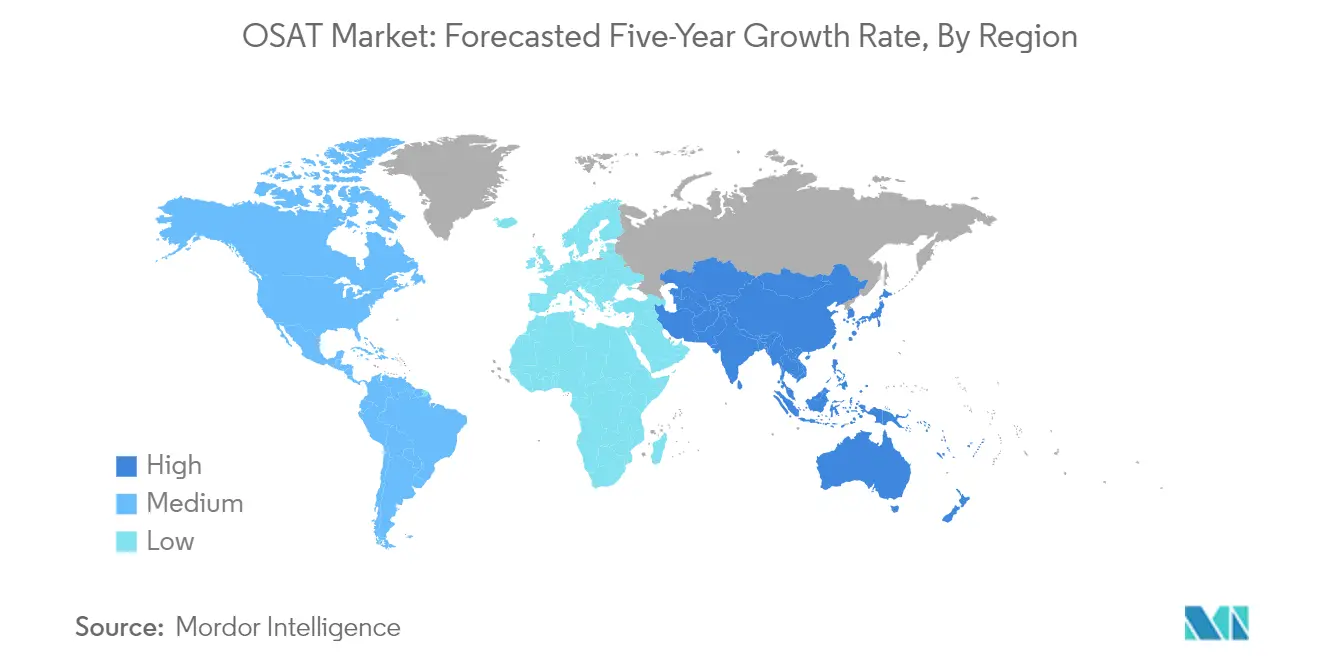
OSAT Market in South Korea
South Korea emerges as the most dynamic market in the OSAT sector, projected to grow at approximately 11% annually from 2024 to 2029. The country's robust growth is driven by its strategic position as home to prominent chip makers in the consumer electronics segment, notably Samsung and SK Hynix. The Korean government's ambitious focus on smart manufacturing, aiming to establish 30,000 fully automated manufacturing companies by 2025, provides a strong foundation for OSAT services growth. The semiconductor testing sector has experienced significant expansion, particularly with Samsung Electronics' growing system semiconductor business. Local semiconductor testing companies such as NEPES Ark, LB Semicon, Tesna, and Hana Micron have been actively investing in facilities and equipment to handle increased supplies of system semiconductors. The country's commitment to semiconductor advancement is further evidenced by its implementation of the "K-Chips Act," which provides substantial tax benefits to encourage investments in the semiconductor industry.
OSAT Market in China
China's OSAT market demonstrates remarkable resilience and growth potential, supported by robust government initiatives and strategic investments in semiconductor manufacturing capabilities. The country maintains a thriving semiconductor packaging business, hosting 22% of all assembly, testing, and packaging facilities worldwide. Chinese testing and packaging companies continue to gain processing capacity for high-end packaging technologies, including flip-chip, bumping, and more advanced processes like fan-in, fan-out, 2.5D interposer, and SiP. Major Chinese semiconductor OSAT companies like JCET, TSHT, and TFME are projected to outperform the industry average in revenue performance. The country's commitment to semiconductor self-sufficiency is evident through various government support programs and investments in advanced packaging technologies. The integration of smart technologies and the rapid adoption of electric vehicles in China further amplify the demand for sophisticated OSAT services.
OSAT Market in United States
The United States maintains its position as a crucial market in the global OSAT sector, driven by increasing demand for consumer electronics and advancements in next-generation electric vehicles. The country's semiconductor sector benefits from substantial government support through the CHIPS Act, which focuses on increasing domestic semiconductor fabrication and advanced packaging capabilities. American OSAT providers are particularly focused on developing innovative packaging solutions for automotive applications, high-performance computing, and 5G telecommunications. The market is characterized by strong research and development activities, with companies investing heavily in advanced packaging technologies and test solutions. The increasing adoption of artificial intelligence, Internet of Things devices, and autonomous vehicles continues to create new opportunities for OSAT services in the country.
OSAT Market in Other Countries
Beyond the major markets, the OSAT industry maintains a significant presence across various countries, each contributing uniquely to the global semiconductor ecosystem. Japan leverages its strong integrated circuits manufacturing base and continues to advance in automotive semiconductor applications. Malaysia positions itself as an emerging OSAT hub, benefiting from the ongoing global semiconductor supply chain realignment. OSAT companies in Malaysia are increasingly recognized for their role in the semiconductor assembly services sector. Singapore focuses on high-value OSAT services, particularly in advanced packaging technologies and test solutions. These countries collectively contribute to the industry's diversification and resilience, offering specialized services and technological capabilities that complement the major markets. The varying strengths of these markets, from Malaysia's manufacturing expertise to Singapore's advanced testing capabilities and Japan's automotive semiconductor focus, create a robust and interconnected global OSAT ecosystem.
Outsourced Semiconductor Assembly and Test (OSAT) Market Overview
Top Companies in OSAT Market
The OSAT market is characterized by continuous innovation and strategic expansion by key players like ASE Group, Amkor Technology, JCET, Powertech Technology, and ChipMOS Technologies. These leading OSAT companies are heavily investing in advanced packaging technologies, including 2.5D, 3D-IC, fan-out wafer-level packaging, and system-in-package solutions to meet evolving industry demands. Strategic facility expansions, particularly in emerging Asian markets like Vietnam, Malaysia, and India, demonstrate the industry's focus on geographical diversification and capacity enhancement. Players are strengthening their positions through strategic partnerships with semiconductor manufacturers and foundries while investing significantly in automation and artificial intelligence to improve operational efficiency. The emphasis on research and development of specialized packaging solutions for emerging applications like 5G, automotive electronics, and artificial intelligence showcases the industry's commitment to technological advancement and market leadership.
Asian Dominance Shapes Market Competition Dynamics
The OSAT market exhibits a high degree of consolidation with Asian companies, particularly from Taiwan and China, dominating the competitive landscape. The top players control a significant portion of the market share, with Taiwan-based companies holding prominent positions due to their advanced technological capabilities and established relationships with global semiconductor manufacturers. The market structure is characterized by a mix of large integrated device manufacturers offering in-house services and specialized OSAT semiconductor companies, with increasing vertical integration becoming a notable trend among major foundries entering the packaging and testing space.
The industry has witnessed strategic consolidations through mergers and acquisitions, particularly among Chinese players supported by government initiatives like "Made in China 2025." Companies are increasingly focusing on establishing strategic partnerships and joint ventures to enhance their technological capabilities and market reach. The competitive dynamics are further influenced by the growing trend of foundries and integrated device manufacturers expanding their packaging operations, creating additional pressure on pure-play OSAT vendors to differentiate their offerings and maintain market position.
Innovation and Integration Drive Future Success
Success in the OSAT market increasingly depends on companies' ability to develop advanced packaging solutions while maintaining cost competitiveness. Incumbent players are focusing on expanding their technology portfolios through investments in research and development, particularly in areas like heterogeneous integration and advanced system-in-package solutions. The ability to offer turnkey solutions, including design support and testing services, has become crucial for maintaining market position, while strategic partnerships with foundries and semiconductor designers help ensure steady business flow and technology alignment.
Market contenders are finding opportunities by specializing in niche applications and emerging technologies, particularly in automotive electronics and 5G infrastructure. The industry's future success factors include the ability to manage supply chain relationships, maintain technological leadership in specific market segments, and adapt to evolving customer requirements. Environmental compliance and sustainability initiatives are becoming increasingly important differentiators, while the ability to navigate regional regulations and trade policies remains crucial for long-term success. Companies must also balance capacity expansion with market demand fluctuations while maintaining operational efficiency to remain competitive. The OSAT rankings of companies often reflect their ability to innovate and integrate new technologies effectively, ensuring their leadership in the semiconductor assembly and test services sector.
Outsourced Semiconductor Assembly and Test (OSAT) Market Leaders
-
ASE Technology Holding Co. Ltd
-
Amkor Technology Inc.
-
Powertech Technology Inc.
-
ChipMOS Technologies Inc.
-
King Yuan Electronics Co. Ltd
- *Disclaimer: Major Players sorted in no particular order
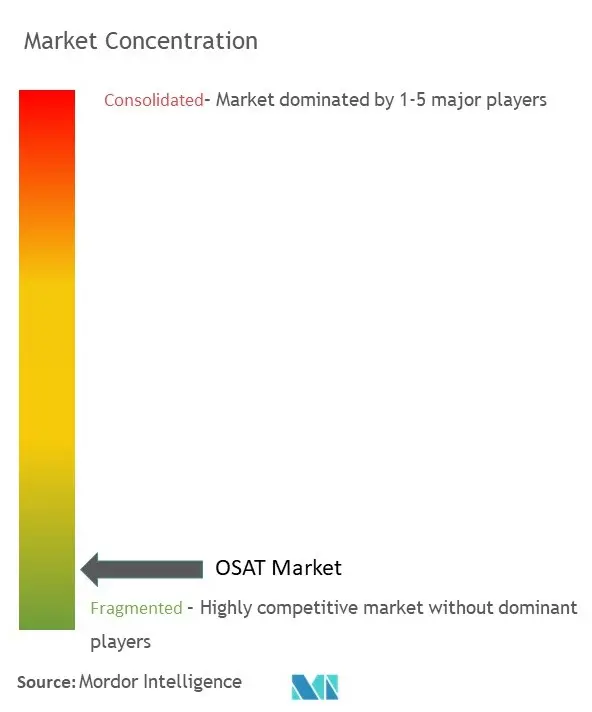
Outsourced Semiconductor Assembly and Test (OSAT) Market News
- December 2023 - Sahasra Electronics, a Noida-based company, revealed its intention to allocate approximately INR 350 crore (USD 42.2 million) over the next three years. The investment will be directed toward establishing a semiconductor packaging facility and expanding manufacturing operations as part of the 'Make in India' initiative. The company plans to acquire electronic assembly machines, resulting in an investment exceeding INR 150 crore (USD 18.1 million) for the plant, while an additional INR 50 crore (USD 6 million) will be dedicated to the interior of the building. Such investments in boosting the semiconductor packaging and assembly services are expected to increase the market’s potential.
- November 2023 - JCET Automotive Electronics (Shanghai) Co. Ltd is scheduled to receive a capital injection of RMB 4.4 billion (USD 0.61 billion), resulting in a total registered capital of RMB 4.8 billion (USD 0.67 billion). This investment will hasten the establishment of an advanced packaging facility for automotive chip products in the Lingang Special Area of Shanghai.
Outsourced Semiconductor Assembly and Test (OSAT) Market Industry Segmentation
OSAT companies offer third-party integrated circuit (IC) packaging and test services. These companies provide packaging for silicon devices made by foundries and test the devices before shipping. They focus on offering innovative packaging and test solutions for semiconductor companies in well-established markets, such as communications, consumers, and computing, as well as emerging markets, such as automotive electronics, the Internet of Things (IoT), and wearable devices.
The outsourced semiconductor assembly and test services (OSAT) market is segmented by service type (packaging and testing), type of packaging (ball grid array packaging, chip-scale packaging, stacked die packaging, multi-chip packaging, and quad flat and dual-inline packaging [only qualitative analysis is included]), application (communication, consumer electronics, automotive, computing and networking, industrial, and other applications), and geography (United States, China, Taiwan, South Korea, Malaysia, Singapore, Japan, and Rest of the World). The report includes market forecasts and size in value in USD for all the above segments.
| By Service Type | Packaging |
| Testing | |
| By Type of Packaging | Ball Grid Array (BGA) Packaging |
| Chip Scale Packaging (CSP) | |
| Stacked Die Packaging | |
| Multi Chip Packaging | |
| Quad Flat and Dual-inline Packaging | |
| By Application | Communication |
| Consumer Electronics | |
| Automotive | |
| Computing and Networking | |
| Industrial | |
| Other Applications | |
| By Geography | United States |
| China | |
| Taiwan | |
| South Korea | |
| Malaysia | |
| Singapore | |
| Japan |
| Packaging |
| Testing |
| Ball Grid Array (BGA) Packaging |
| Chip Scale Packaging (CSP) |
| Stacked Die Packaging |
| Multi Chip Packaging |
| Quad Flat and Dual-inline Packaging |
| Communication |
| Consumer Electronics |
| Automotive |
| Computing and Networking |
| Industrial |
| Other Applications |
| United States |
| China |
| Taiwan |
| South Korea |
| Malaysia |
| Singapore |
| Japan |
Outsourced Semiconductor Assembly and Test (OSAT) Market Research FAQs
How big is the OSAT Market?
The OSAT Market size is expected to reach USD 47.10 billion in 2025 and grow at a CAGR of 8.62% to reach USD 71.21 billion by 2030.
What is the current OSAT Market size?
In 2025, the OSAT Market size is expected to reach USD 47.10 billion.
Who are the key players in OSAT Market?
ASE Technology Holding Co. Ltd, Amkor Technology Inc., Powertech Technology Inc., ChipMOS Technologies Inc. and King Yuan Electronics Co. Ltd are the major companies operating in the OSAT Market.
What years does this OSAT Market cover, and what was the market size in 2024?
In 2024, the OSAT Market size was estimated at USD 43.04 billion. The report covers the OSAT Market historical market size for years: 2019, 2020, 2021, 2022, 2023 and 2024. The report also forecasts the OSAT Market size for years: 2025, 2026, 2027, 2028, 2029 and 2030.
Page last updated on: December 24, 2024

